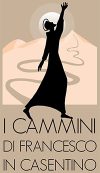Menu
Annual event, often in February. Dates vary. Approx. 70 days before Easter, ending on Fat Tuesday (Mardi Gras).
Free
Parades and activities for all ages, costumes encouraged. Large crowds, plan accommodation in advance.
Carnival in Italy is a festive celebration occurring between January and March, depending on the location. The event dates back centuries and has deep roots in the culture and history of Italy.
It originally symbolized the period of abstinence and fasting before Easter, but now Carnival is an inclusive celebration enjoyed by all faiths.
Throughout the towns and villages along the Via di Francesco pilgrimage trail, Carnival events include colorful parades, floats, and fun activities for children and adults alike. Many parades showcase creative and intricate paper-mache floats, which often poke fun at politics, events, and personalities of the past year.
Participants are encouraged to wear costumes and masks, making the atmosphere lively and engaging. The Carnival of Florence, for example, features a grand parade with musical bands, dancers, and street artists, while other towns hold their own unique events.
Carnival occurs annually, typically between January and March, during the 40 days before Lent, and 70 days before Easter.
Carnival Calendar
The origins of the Carnival of Florence date back to the 15th century, during the Medici’s rule. Over time, the traditions have evolved to include parades, float races, all-night parties, and balls in theaters.
Today, the Carnival of Florence is celebrated with grand parades, colorful costumes, and the appearance of the famous character Stenterello.
Carnival is celebrated throughout Italy, with each town and city hosting their own unique events and activities. The spirit of Carnival unites the country in a shared moment of joy and liberation before the period of Lent.
Carnival in Italy has ancient roots, with its origins traced back to the Roman Saturnalia and the Greek Dionysian celebrations. The tradition of wearing masks and costumes during Carnival began in the 16th century when the Lorena family ruled Tuscany.
In Florence, the character Stenterello was created at the end of the 18th century as a representation of the common people, often criticizing authority with humor and irony. Today, the spirit of Carnival remains alive and vibrant throughout Italy, with the celebrations representing the independent and often irreverent Tuscan personality.
By entering your email, you get the Quick Start emails, free Pilgrim Essentials Kit, and more resources, and agree to our Terms & Conditions and Privacy Policy.

An opportunity for pilgrims, seekers, and adventurers to take an inward journey alongside the spirit of St Francis.

A Toscana, non-religious non-profit to share the discovery and preservation of Franciscan tradition, Nature, and Art.
Disclosure: We may receive affiliate compensation for some of the links on this site if you decide to purchase linked items, helping us to maintain our trails and provide services to our community of pilgrims. Read our affiliate disclosure in our privacy policy.
By entering your email, you get the Quick Start emails, free Pilgrim Essentials Kit, and more resources, and agree to our Terms & Conditions and Privacy Policy.

An opportunity for pilgrims, seekers, and adventurers to take an inward journey alongside the spirit of St Francis.

A Toscana, non-religious non-profit to share the discovery and preservation of Franciscan tradition, Nature, and Art.
Disclosure: We may receive affiliate compensation for some of the links on this site if you decide to purchase linked items, helping us to maintain our trails and provide services to our community of pilgrims. Read our affiliate disclosure in our privacy policy.